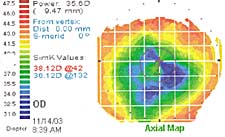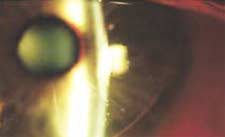Specialty GP lens addresses post-RK patient’s progressive hyperopia
|
Some patients who underwent radial keratotomy in the 1980s or early 1990s are now experiencing hyperopic shifts or progressive hyperopia. We, as eye care providers, are seeing them as patients in our clinics as their vision changes, and often they are requesting alternatives to spectacles.
Many of these patients cannot obtain good comfort or clarity with spectacles. Excellent, reliable surgical outcomes may not be reasonable yet for post-RK patients. In addition, these patients pose a significant challenge to contact lens fitting, not only because of their irregularly shaped corneas, but also because of their frustration with their changing vision. Creativity, patience and new contact lens designs may be the key to helping them meet their goals.
Case report: fluctuating vision
P.A. was a 51-year-old man who came to my clinic with worsening vision. His chief complaint was that he was having trouble seeing fine print at work and that his vision seemed to fluctuate, especially when he was fatigued. He had already seen a corneal surgeon in hopes of having a surgical procedure to improve his vision, but no promising options were offered.
P.A.’s ocular history included RK and astigmatic keratotomy in both eyes in 1995. The incisional surgery was enhanced in both eyes about 1 year later, and then again in the right eye shortly after that. LASIK was not approved at that time, and many surgeons were offering and performing RK and astigmatic keratotomy for their patients with myopia and astigmatism.
I was fortunate to know P.A.’s preoperative information from files he had kept. Preoperatively, his manifest refraction readings were –4.25 +1.25 x 093 20/20 in the right eye and –5.75 +3.00 x 080 20/20-3 in the left eye. His preoperative keratometry readings were 41.75 x 43.25 in the right eye and 41.75 x 44.25 in the left eye. Preoperative topography was normal with a symmetric bow tie and with-the-rule astigmatism.
Immediately after the initial RK surgery, P.A.’s right eye was –1.50 +1.00 x 080 20/20-, and the left eye was –0.75 +0.75 x 115 20/20-. Uncorrected visual acuities were 20/80 in the right eye and 20/30 in the left eye. The undercorrection caused blurry distance vision. The surgeon suggested incisional enhancements, and the patient agreed. He performed well with glasses for about 5 years after the last enhancement.
When I first examined P.A. in late 2003, he was wearing glasses in this prescription with this vision: +1.50 +1.75 x 075 20/50 in the right eye and +0.50 +0.75 x 068 20/25 in the left eye. These had been prescribed in 2000, about 3 years prior to my first visit with him.
My manifest refraction showed a significant hyperopic shift in the right eye: +4.50 +2.00 x 050 20/25+1 +1.75 J2 in the right eye and +0.75 +0.75 x 035 20/25 +1.75 J2 in the left eye.
Slit lamp exam showed eight radial incisions with two astigmatic arcuate incisions at the 90° and 270° axes in both eyes. In the right eye, the incision at 4 o’clock was within 2 mm of the optic axis. Corneal topography showed central flattening with irregular astigmatism in both eyes. The simulated K values by Orbscan topography (Bausch & Lomb, Rochester, N.Y.) were 38.12 @ 42 x 36.12 @ 132 in the right eye and 38.25 @ 178 x 34.87 @ 88 in the left eye.
The patient’s goals
|
P.A.’s goal was to improve the vision in his right eye. He was not unhappy with his uncorrected vision in the left eye; however, the anisometropia was causing eyestrain at his job as a mortgage broker, and computer and fine print were challenging.
We discussed his options, and he reluctantly chose to be fit with a contact lens in the right eye only. P.A. had worn contact lenses more than 20 years ago and was not looking forward to beginning again.
I fit his right eye with a Dyna-Intralimbal lens (Lens Dynamics, Golden, Colo.) with these parameters: BC 41.00, diameter 11.2 mm, OZ 9.4 mm, power –3.62 D. This gave him crisp visual acuity of 20/20 in the right eye. His uncorrected vision in the left eye was 20/30. He was happy with the balance.
The Dyna-Intralimbal lens is a newer, large-diameter, gas-permeable lens that was approved by the Food and Drug Administration in March 2002. It is marketed as a highly reproducible lens with proprietary peripheral systems, designed especially for patients with highly asymmetric corneas, including those with pellucid marginal degeneration, globus keratoconus, post-penetrating keratoplasty and less-than-perfect post-refractive surgery outcomes.
Fitting post-RK corneas
A post-RK cornea is flatter centrally and steeper mid-peripherally. Generally, on an irregular cornea such as this, centration is poor with a small diameter contact lens, and the movement keeps the vision from stabilizing satisfactorily. A large overall diameter and a correspondingly large optic zone should stabilize better.
With P.A.’s post-RK corneas, the flat central area was surrounded by a steeper “elbow” mid-peripherally. For these corneas, Dyna-Intralimbal recommends that the first base curve selected is 1 D steeper than the flat central K. In P.A., this was too flat, and a base curve closer to the original flat K (41 D) was needed for centration, comfort and movement.
Examining postoperative topography and choosing the curvature 4.0 mm from central is another way to find the best base curve for most of these patients. Getting as close to alignment with the corneal curves is the goal. Minimal central vaulting should exist. Patients should be trial fit before ordering. Empiric fits will not yield as accurate results.
The large overall diameter lens, 11.2 mm, with a large optic zone, 9.4 mm, moved very little and did not bear on the mid-periphery nor impinge on the limbus. Minimal vaulting existed.
This post-RK patient was very reluctant to consider a contact lens. He was surprised at his comfort level and his improved visual acuity and balance between the two eyes with one right contact lens. He wears the lens full-time and is pleased with his decision.

![Marlane J. Brown, OD, FAAO [photo]](/~/media/shared-images/marlane-j-brown-od-faao-photo.jpg) Marlane J. Brown, OD, FAAO, is a contact lens specialist and provides surgical comanagement at Minnesota Eye Consultants. She can be reached at 710 East 24th Street, #106, Minneapolis, MN 55404; (612) 813-3621; fax: (612) 813-3636; e-mail:
Marlane J. Brown, OD, FAAO, is a contact lens specialist and provides surgical comanagement at Minnesota Eye Consultants. She can be reached at 710 East 24th Street, #106, Minneapolis, MN 55404; (612) 813-3621; fax: (612) 813-3636; e-mail: 
